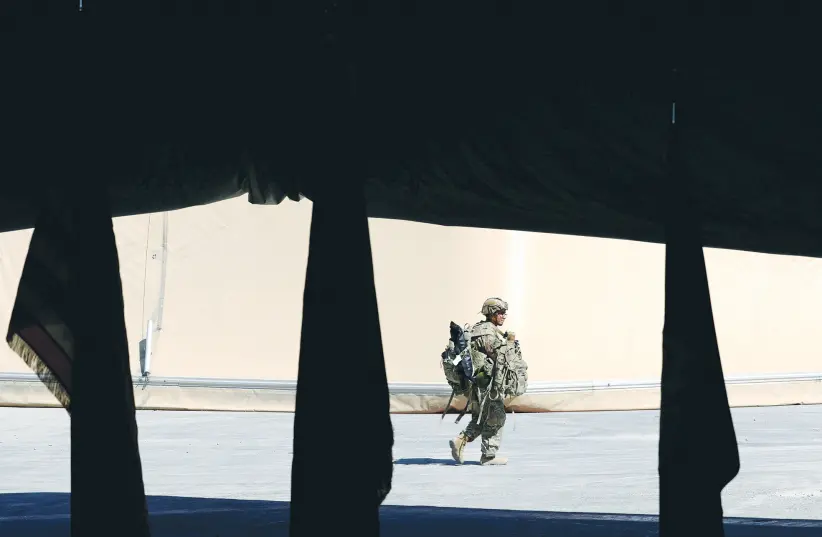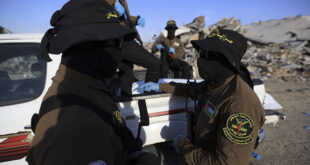BEHIND THE LINES: Around 20 attacks against US personnel and facilities have been carried out since President Joe Biden’s inauguration in January. But the slow build-up of attacks started earlier.
A notable uptick in attacks on US personnel and facilities in Iraq has taken place in recent weeks. In the latest incident on Sunday, five rockets were fired at the Balad Air Base, which hosts US personnel. F16 aircraft are stationed at the base. Two foreign contractors and three Iraqi soldiers were wounded. According to a report by Agence France-Presse, two of the rockets landed in the dormitory and canteen of a US contracting company, Sallyport Global Services. The company provides security, training and utilities at Balad.
The Balad attack followed a drone strike on the airport at Erbil on Wednesday. US troops are stationed at the airport, located in the usually peaceful and stable Kurdish autonomous region. This was the first recorded use of a drone against a US target by the Iran-linked Shia militias in Iraq. A rocket attack in February at the airport killed one Iraqi civilian and a contractor working with US forces.
Around 20 attacks against US personnel and facilities have been carried out since President Joe Biden’s inauguration in January. But the slow build-up of attacks started earlier, and was identifiable from late 2019.
It was in the framework of this escalation that the US took the dramatic step of assassinating Quds Force Commander Qasem Soleimani, and Kata’ib Hezbollah founder Abu Mahdi al-Muhandis, on January 7, 2020. This strike followed the killing of a US contractor in a Kata’ib Hezbollah rocket attack on the K1 base near Kirkuk in December 2019.
Soleimani was the mastermind of the Iranian strategic use of proxy political-military groups as a tool of power projection across the region. Al-Muhandis was among his most capable lieutenants, and was the main implementer of this strategy in Iraq. But if the killing was intended to produce a feeling of shock and awe among the pro-Iranian militias, and a consequent decision not to tangle with the Americans, it has evidently failed to achieve its objective. The slow Shia militia/Iranian insurgency against the US presence in Iraq has survived Soleimani and al-Muhandis, and is now gathering pace.
What is the objective of this insurgency? The Iranians want to produce a withdrawal under fire of the 2,500 US service personnel currently present in Iraq.
That this insurgency is gathering speed at a time when US and Iranian representatives are meeting in Vienna in an effort to revive the JCPOA nuclear agreement should come as no surprise to those familiar with Iranian methods. Recall that the negotiations toward the original JCPOA took place in 2013-15, when the Syrian civil war was at its height.
During that period, the entire regional network of Iranian proxy political-military groups had been mobilized to defend the Assad regime from the insurgency against it. The US, meanwhile, was a nominal, though somewhat half-hearted supporter of the Syrian rebellion.
The Iranians considered that warfare by proxy would be a useful accompaniment to negotiation. It might serve to concentrate the Americans’ minds on the serious nature of their negotiating partner. More concretely, the importance of a positive result to the nuclear negotiations might well incline the Americans toward a more pliant stance on the other files, making a victorious conclusion to the offensive more likely.
IN THE SYRIAN case, this was exactly what transpired. Washington’s determination to ensure a successful conclusion to the negotiations was a significant factor contributing to the lukewarm support afforded the rebellion. That in turn led first to the rebellion becoming dominated by Islamist and Sunni jihadi elements, and then to its defeat by the Assad regime and its Iranian and Russian allies.
Tehran has no doubt studied this playbook carefully. The Iranians will also have noted the recent commitment by the Biden administration to withdraw its forces from Afghanistan by September of this year. They may well have concluded that all these indications point to the possibility of repeating the Afghanistan and the Syria situation in Iraq. The months ahead will tell if they are right.
If it turns out that they are, and the remaining 2,500 US service personnel in Iraq are withdrawn, what is likely to follow?
Here, the appropriate comparison is with a different Middle Eastern country: Lebanon. Iran today is in a position of full-spectrum dominance in Lebanon. Its Hezbollah proxy is the most powerful military force in the country. It also, with its allies, has a majority in the parliament and can make and remake governments at will. It also controls the most powerful intelligence bodies, and has a powerful economic presence. The fact that this structure is currently causing and presiding over the generalized collapse of Lebanon and its transformation into a failed state does not make it any less so.
Iraq is not yet in the same position as Lebanon. There are powerful and also significant military forces – most importantly, the Counter-Terrorism Service – which are not in the pocket of, and not intimidated by the pro-Iranian element. But it is clear that the writ of the government of Prime Minister Mustafa Kadhimi does not apply across the country. Rather, the Iran-linked militias (“Waliyi” militias, as they are known in Iraq, after the Iranian system of governance – Wilayat al-Faqiya, or government of the jurisprudent), operate freely. They have vast economic holdings, secret prisons, even control of some border crossings.
The al-Qa’im/al-Bukamal border crossing between Iraq and Syria is a vital strategic node for the Iranians. It is the route through which weaponry transported by road from Iran makes its way into Syria, and sometimes on to Lebanon. Today, the crossing and the area surrounding it in Iraq and into Syria is under the direct control of the IRGC and the Iraqi Shia militias. On the Nineveh Plains, the 30th Brigade of the Badr organization prevents Iraqi Christians from coming back to the homes from which they fled ISIS in 2014. In Sinjar, the militias are mobilized to preserve an additional access route to Syria. And so on.
The examples of Lebanon, Syria, and perhaps also Yemen suggest that without direct and active American support, anti-Iran forces (with the exception of Israel) have trouble making headway, and quickly founder. This fact explains the current Iranian push to make the ground burn beneath the feet of the remaining American forces in Iraq. Tehran understands that in order to reach the prize of the Lebanonization of Iraq, it must first expel the American presence. This issue is set to be tested in the period ahead.
 Eurasia Press & News
Eurasia Press & News




